When is Liposuction Not Recommended Understanding Liposuction
What is Liposuction?
Liposuction is a cosmetic surgical procedure designed to remove excess fat deposits from specific areas of the body. This technique helps contour and reshape various body parts, improving overall appearance and body proportions. Dr. Tarek, a renowned plastic surgeon, emphasizes that liposuction is not a weight-loss solution but rather a method to target stubborn fat pockets resistant to diet and exercise.
Fat Removal Procedure
Fat Removal Procedure is a way to take out extra fat from your body it helps people look slimmer and can be done in different parts of the body
The procedure involves making small incisions in the skin and inserting a thin tube called a cannula to suction out fat cells. Liposuction can be performed on its own or in combination with other cosmetic procedures for enhanced results.
Common Areas for Liposuction Treatment
Liposuction can be applied to various parts of the body where excess fat tends to accumulate. Some of the most common areas include:
Book A Consultation With Dr Tarek Bayazid
Top-rated Plastic Surgeon For Liposuction in Dubai
Installment Plan Available
- Abdomen and waistline
- Thighs (inner and outer)
- Hips and buttocks
- Arms (upper and lower)
- Back and bra line
- Chest (especially for men with gynecomastia)
- Neck and chin (double chin)
- Knees and ankles
Types of Liposuction Procedures
There are several types of liposuction techniques available, each with its own advantages:
- Tumescent Liposuction: This is the most common technique, involving the injection of a saline solution mixed with anesthetic and epinephrine to minimize bleeding and discomfort.
- Ultrasound-Assisted Liposuction (UAL): Uses ultrasonic energy to liquefy fat cells before removal, making it easier to suction out stubborn fat.
- Laser-Assisted Liposuction (SmartLipo): Employs laser energy to break down fat cells and tighten the skin simultaneously.
- Power-Assisted Liposuction (PAL): Utilizes a vibrating cannula to break up fat deposits more efficiently.
- Water-Assisted Liposuction (WAL): Uses a gentle stream of water to dislodge fat cells while preserving surrounding tissues.
|
Liposuction Technique |
Key Benefits |
Best Suited For |
|
Tumescent |
Minimal blood loss, faster recovery |
Most body areas |
|
Ultrasound-Assisted |
Effective for fibrous areas |
Back, male chest |
|
Laser-Assisted |
Skin tightening effects |
Small areas, mild skin laxity |
|
Power-Assisted |
Reduced surgeon fatigue, precise sculpting |
Large volume fat removal |
|
Water-Assisted |
Gentle on tissues, less bruising |
Delicate areas, fat transfer |
Unrealistic Expectations
What Liposuction Can and Cannot Achieve
Liposuction is an effective body contouring procedure, but it’s essential to understand its limitations. Dr. Tarek stresses the importance of having realistic expectations about the outcomes of liposuction.
Liposuction can:
- Remove localized fat deposits
- Improve body proportions
- Enhance overall silhouette
Liposuction cannot:
- Serve as a weight loss method
- Eliminate cellulite or stretch marks
- Tighten loose or sagging skin
Patients expecting liposuction to dramatically alter their body shape or serve as a substitute for a healthy lifestyle may not be suitable candidates. It’s crucial to approach the procedure with a clear understanding of its capabilities and limitations.
Smoking and Liposuction
Risks Associated with Smoking
Smoking significantly increases the risks associated with liposuction and can negatively impact the healing process. Nicotine constricts blood vessels, reducing blood flow to tissues and impairing the body’s ability to heal properly.
Smokers face a higher risk of complications such as:
- Delayed wound healing
- Increased risk of infection
- Poor skin quality and reduced elasticity
- Increased risk of blood clots
- Longer recovery time
Pre-Surgery Smoking Cessation
For optimal results and reduced risks, Dr. Tarek advises patients to quit smoking at least four to six weeks before the liposuction procedure. This allows time for the body to begin recovering from the effects of nicotine and other harmful substances in cigarettes.
Patients should also commit to abstaining from smoking for at least four to six weeks after the surgery to ensure proper healing and minimize complications. Nicotine replacement therapies may be recommended to help manage cravings during this period.
|
Time Frame |
Action |
|
4-6 weeks before surgery |
Quit smoking |
|
During recovery (4-6 weeks) |
Continue to abstain from smoking |
|
Long-term |
Consider permanent smoking cessation for overall health |
Ideal Candidates for Liposuction 
Physical Health Requirements
BMI Considerations
Body Mass Index (BMI) is an important factor in determining candidacy for liposuction. Ideal candidates typically have a BMI below 30, which falls within the normal to slightly overweight range.
Patients with a BMI over 30 may still be considered for liposuction, but the risks and potential complications increase. Dr. Tarek evaluates each case individually, taking into account overall health, fat distribution, and the patient’s goals.
- Ideal BMI range for liposuction: 18.5 – 29.9
- BMI 30 – 34.9: May be considered with caution
- BMI 35+: Generally not recommended; weight loss advised before considering liposuction
Skin Elasticity
Good skin elasticity is crucial for achieving optimal results from liposuction. Patients with firm, elastic skin are more likely to experience smooth contouring after fat removal.
Factors affecting skin elasticity include:
- Age
- Genetics
- Sun exposure
- Weight fluctuations
- Smoking history
Dr. Tarek assesses skin quality during the consultation to determine if liposuction alone will provide satisfactory results or if additional skin tightening procedures may be necessary.
Lifestyle Factors
Commitment to Maintaining Weight
Ideal liposuction candidates demonstrate a commitment to maintaining a stable weight through proper diet and regular exercise. Liposuction results can be long-lasting when patients maintain their weight post-procedure.
Significant weight gain after liposuction can lead to uneven fat distribution and compromise the aesthetic outcome. Patients should be prepared to adopt or continue a healthy lifestyle to preserve their results.
Diet and Exercise Regimen
A balanced diet and consistent exercise routine are essential for ideal liposuction candidates. These habits not only help maintain results but also contribute to overall health and well-being.
Recommended lifestyle habits for liposuction candidates:
- Regular cardiovascular exercise (at least 150 minutes per week)
- Strength training to build lean muscle mass
- Balanced, nutrient-rich diet
- Adequate hydration
- Stress management techniques
|
Lifestyle Factor |
Importance for Liposuction Candidates |
|
Stable Weight |
Crucial for long-lasting results |
|
Regular Exercise |
Maintains overall health and body contours |
|
Balanced Diet |
Supports healing and prevents weight gain |
|
Non-Smoking |
Reduces surgical risks and improves healing |
|
Stress Management |
Promotes overall well-being and recovery |
Preparing for Liposuction 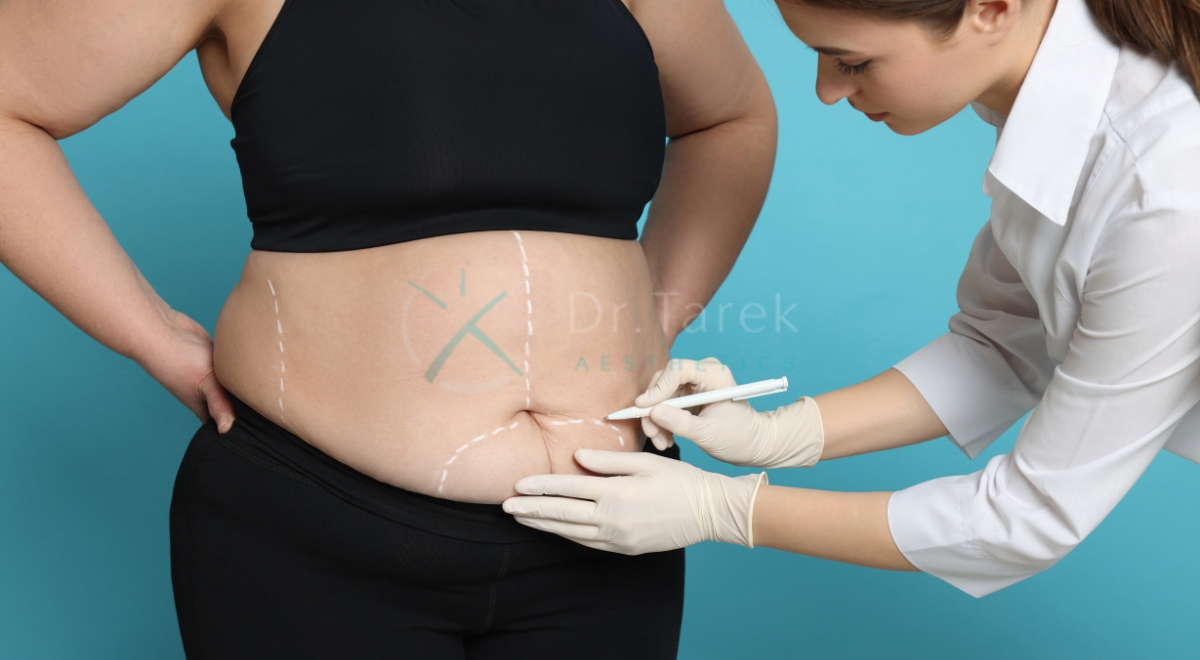
Pre-Surgery Consultations
What to Discuss with Dr. Tarek
During your pre-surgery consultation, it’s essential to have an open and honest discussion with Dr. Tarek about your goals, expectations, and medical history. This conversation helps ensure that liposuction is the right choice for you and allows for proper planning of the procedure.
Key points to discuss include:
- Your motivations for seeking liposuction
- Specific areas of concern on your body
- Previous surgeries or medical treatments
- Current medications and supplements
- Allergies, especially to medications
- Lifestyle habits, including smoking and alcohol consumption
- Recovery expectations and time off work
Necessary Medical Tests
To ensure your safety during the procedure, Dr. Tarek may recommend several medical tests before scheduling your liposuction. These tests help identify any underlying health issues that could affect your surgery or recovery.
Common pre-liposuction medical tests include:
- Complete blood count (CBC)
- Coagulation profile
- Liver function tests
- Kidney function tests
- Electrocardiogram (ECG) for patients over 40 or with cardiac risk factors
- Chest X-ray, if indicated
Pre-Operative Instructions
Medications to Avoid
Certain medications and supplements can increase the risk of bleeding or interfere with anesthesia during liposuction. Dr. Tarek will provide a comprehensive list of medications to avoid in the weeks leading up to your surgery.
Common medications and supplements to avoid include:
- Aspirin and other blood thinners
- Non-steroidal anti-inflammatory drugs (NSAIDs) like ibuprofen
- Vitamin E supplements
- Herbal supplements such as ginkgo biloba and St. John’s Wort
Always consult with Dr. Tarek before stopping any prescribed medications.
Dietary Restrictions
Following proper dietary guidelines before liposuction can help reduce the risk of complications and promote faster recovery. Dr. Tarek will provide specific instructions tailored to your individual needs.
General pre-operative dietary guidelines:
- Stay well-hydrated in the days leading up to surgery
- Avoid alcohol for at least a week before the procedure
- Eat a healthy, balanced diet rich in vitamins and minerals
- Avoid large meals the night before surgery
- Follow fasting instructions as provided by Dr. Tarek, typically no food or drink after midnight before the surgery day
|
Time Frame |
Action |
|
2 weeks before |
Stop taking blood thinners and certain supplements |
|
1 week before |
Avoid alcohol consumption |
|
Night before |
Light, healthy meal; no food or drink after midnight |
|
Morning of surgery |
Follow Dr. Tarek’s specific instructions |
The Liposuction Procedure
What to Expect During Surgery
Anesthesia Options
The type of anesthesia used during liposuction depends on the extent of the procedure, the areas being treated, and the patient’s preferences. Dr. Tarek will discuss the most appropriate anesthesia option for your specific case.
Common anesthesia options for liposuction include:
- Local anesthesia: Used for small areas, the patient remains awake but numb in the treated area.
- Intravenous sedation: Provides a deeper level of relaxation while keeping the patient semi-conscious.
- General anesthesia: Used for more extensive procedures, the patient is completely unconscious.
Each anesthesia option has its benefits and risks, which Dr. Tarek will explain in detail during your consultation.
Duration of the Procedure
The length of a liposuction procedure can vary significantly depending on several factors:
- Number of areas being treated
- Amount of fat being removed
- Type of liposuction technique used
- Patient’s body type and fat distribution
On average, liposuction can take anywhere from 1 to 4 hours. Small, localized treatments may be completed in under an hour, while more comprehensive body contouring can take several hours.
Dr. Tarek will provide a more accurate estimate of your procedure duration during your pre-operative consultation.
Post-Operative Care
Immediate Aftercare
Proper post-operative care is crucial for a smooth recovery and optimal results. Immediately after the procedure, you can expect:
- To wear compression garments to reduce swelling and support the treated areas
- Some discomfort, which can be managed with prescribed pain medication
- Drainage from incision sites, which is normal for the first 24-48 hours
- Instructions to rest and avoid strenuous activities
Dr. Tarek’s team will provide detailed aftercare instructions and schedule follow-up appointments to monitor your progress.
Long-Term Recovery Tips
Full recovery from liposuction can take several weeks to months. To ensure the best possible outcome:
- Continue wearing compression garments as directed by Dr. Tarek
- Gradually increase activity levels, starting with light walking
- Maintain a healthy diet and stay hydrated to support healing
- Avoid sun exposure on treated areas to prevent discoloration
- Attend all follow-up appointments with Dr. Tarek
- Be patient, as final results may take 3-6 months to become fully apparent
|
Recovery Phase |
Duration |
Key Actions |
|
Immediate |
1-3 days |
Rest, wear compression garments, manage pain |
|
Early |
1-2 weeks |
Limited activity, continue compression |
|
Intermediate |
3-6 weeks |
Gradual return to normal activities |
|
Long-term |
3-6 months |
Full recovery, visible final results |
Risks and Complications
Common Risks
Infection
While rare, infection is a potential complication of liposuction. Dr. Tarek takes extensive precautions to minimize this risk, including sterile surgical techniques and prophylactic antibiotics when necessary.
Signs of infection to watch for include:
- Excessive redness or warmth around incision sites
- Fever or chills
- Foul-smelling discharge from incisions
- Increased pain or swelling beyond what’s expected
If you experience any of these symptoms, contact Dr. Tarek immediately for evaluation and treatment.
Scarring
Liposuction involves small incisions, which typically heal well with minimal scarring. However, some patients may develop more noticeable scars, especially if they have a tendency towards keloid or hypertrophic scarring.
Factors that can affect scarring include:
- Genetic predisposition
- Skin type and color
- Location of incisions
- Post-operative care and sun exposure
Dr. Tarek uses advanced techniques to minimize scarring and can recommend scar management treatments if needed.
How to Minimize Risks
Following Post-Operative Instructions
Adhering to Dr. Tarek’s post-operative instructions is crucial for minimizing risks and ensuring optimal results. These instructions typically include:
- Proper wound care and dressing changes
- Wearing compression garments as directed
- Limiting physical activities during the initial recovery period
- Taking prescribed medications as instructed
- Attending all follow-up appointments
Patients who closely follow these guidelines generally experience smoother recoveries with fewer complications.
Recognizing Signs of Complications
Early detection of potential complications is key to successful management. Be alert for the following warning signs:
- Excessive bleeding or fluid drainage
- Severe, persistent pain not relieved by medication
- Shortness of breath or chest pain
- Significant asymmetry or contour irregularities
- Numbness or changes in skin sensation lasting more than a few weeks
If you experience any of these symptoms, contact Dr. Tarek promptly for evaluation and guidance.
|
Complication |
Warning Signs |
Action |
|
Infection |
Fever, redness, discharge |
Contact Dr. Tarek immediately |
|
Excessive bleeding |
Soaked dressings, severe bruising |
Seek urgent medical attention |
|
Blood clots |
Calf pain, swelling, shortness of breath |
Go to emergency room |
|
Contour irregularities |
Visible lumps or asymmetry |
Schedule follow-up with Dr. Tarek |
Additional Considerations
When to Call Dr. Tarek
Signs of Complications
Patients should contact Dr. Tarek immediately if they experience:
- Severe pain that is not relieved by medication
- Excessive bleeding or oozing from incision sites
- Signs of infection such as fever or unusual discharge
- Shortness of breath or chest pain
- Severe swelling or asymmetry in treated areas
Prompt communication about any concerns can help prevent or address complications early.
Follow-Up Appointments
Regular follow-up appointments are crucial for monitoring recovery and ensuring optimal results. Typical follow-up schedule:
- First-week post-surgery
- Two weeks post-surgery
- One month post-surgery
- Three months post-surgery
- Six months post-surgery
Frequently Asked Questions
Can Liposuction Help with Obesity?
Liposuction is not a treatment for obesity. It is designed to remove localized fat deposits in individuals who are at or near their ideal body weight. For those struggling with obesity, weight loss through diet, exercise, and possibly bariatric surgery are more appropriate options. Liposuction may be considered after significant weight loss to address stubborn areas of fat that remain.
What is the Difference Between Liposuction and a Tummy Tuck?
Liposuction and tummy tucks (abdominoplasty) are distinct procedures with different goals. Liposuction removes excess fat deposits but does not address loose skin or muscle laxity. A tummy tuck, on the other hand, removes excess skin and tightens abdominal muscles, often incorporating liposuction for optimal contouring. The choice between these procedures depends on the patient’s specific concerns and body composition.
How Much Weight Can You Lose with Liposuction?
Liposuction is not a weight loss procedure, and the amount of fat removed is limited for safety reasons. Typically, no more than 5 liters (11 pounds) of fat and fluid combined are removed in a single session. The goal is to improve body contours rather than significantly reduce weight. Patients often notice a change in clothing size and improved proportions rather than a dramatic drop in scale weight.
Does Liposuction Remove Cellulite?
Liposuction is not an effective treatment for cellulite. While it can improve body contours, it does not address the structural causes of cellulite, which involve fibrous bands beneath the skin. In some cases, liposuction may even make cellulite appear more pronounced by removing the fat that was smoothing out the skin’s surface. Specific cellulite treatments are more appropriate for addressing this concern.
Is There a Noninvasive Form of Liposuction?
While traditional liposuction is a surgical procedure, there are several noninvasive fat reduction treatments available. These include cryolipolysis (fat freezing), radiofrequency treatments, and ultrasound-based therapies. These methods can provide modest fat reduction without surgery but typically require multiple sessions and may not be as effective as liposuction for significant fat removal. Dr. Tarek can discuss whether these alternatives might be suitable for your goals.
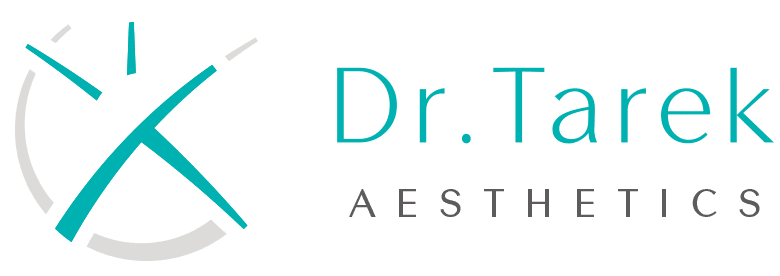

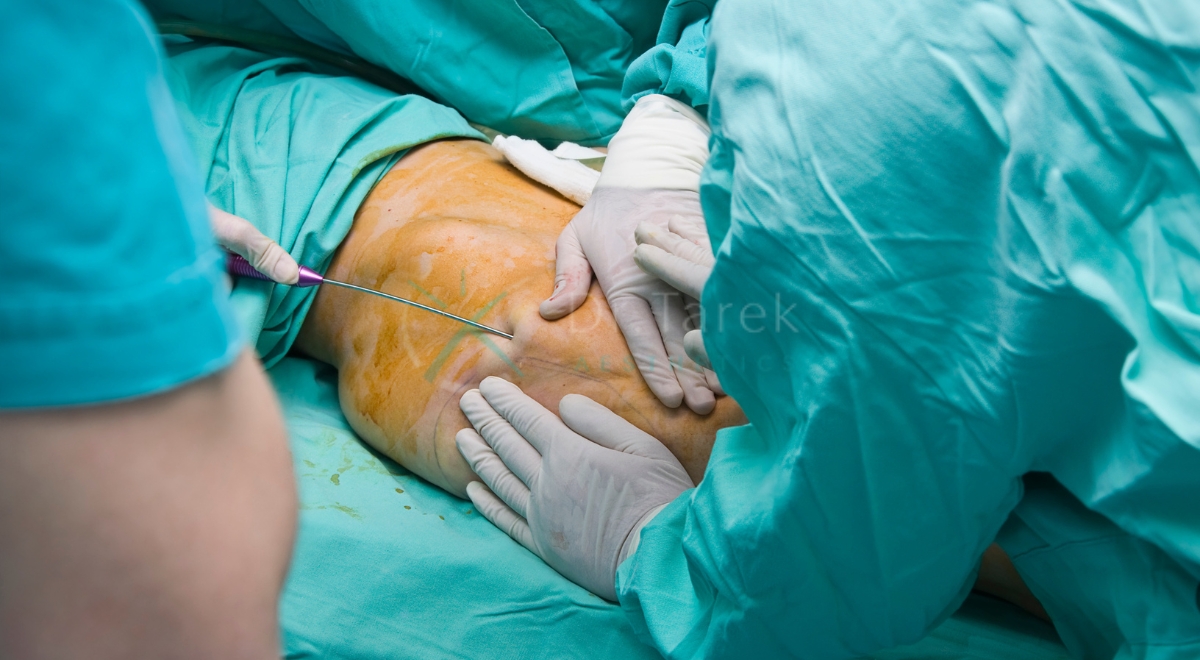


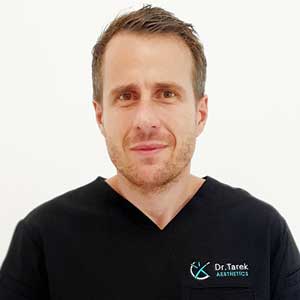



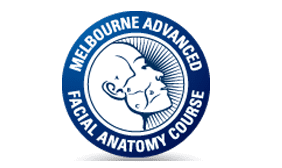

Related Posts